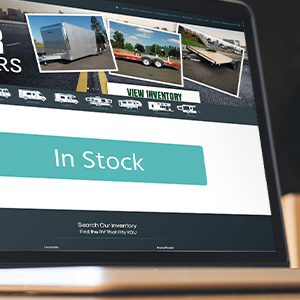Nationwide inventory shortages due to low workforce has affected almost every industry. RV, trailer, powersport and marine dealerships, as well as outdoor outfitters have all felt the hurt of the mass inventory shortage. While national supply shortages are common knowledge to most consumers, it doesn’t take away their frustration when shopping on your website—only to realize you don’t have what they’re looking for. Add a lack of information on your website to low inventory, and you now have the perfect storm for increased bounce rates. Whether you’re a recreational vehicle dealer or retail operation that caters to the outdoor market, visitors quickly leaving your website is never a good thing!
How to Combat Low Inventory Pages on Your Dealer Website
While there isn’t much dealers and retailers can do to fix inventory shortages in supply chains, there are things that can be done to help website visitors. Why should this matter to you? Well, your website visitors are a major portion of your leads and eventual customers! Not to mention, every bounce from your website and little to no SEO on inventory pages count against you, according to Google’s Search Ranking Algorithm. Applying our tips will help your web traffic have a better shopping experience, show visitors the inventory you do have, and keep them on your site longer- keeping your search ranking up!
Don’t Lose Searchability Due to Inventory Shortage
Despite popular belief, website traffic from search engines such as Google and Bing send visitors to internal pages more often than to your home page. This is because, normally, your units or products on inventory pages double as SEO boosters for the pages they are on.

Titles and descriptions of items on inventory pages often provide the SEO content needed to help your search ranking. If you only have a few items, or no items at all on the page, you could have pages on your website deindexed by Google and other search engines. If you have low inventory pages throughout your site due to inventory shortage, you can add SEO-rich content that will help you now and in the future. While it may not give you as much value as actual inventory at full capacity- something is better than nothing for Search Engine Ranking.
Provide Low Inventory Information on the Home Page
Even though a large portion of website visitors will often land on an internal page from a search engine, if they don’t find what they want their next step is likely your home page. Let visitors know what’s going on with inventory shortages through a banner or even a pop up on the home page. If you know your inventory pages are sparse or you have inventory coming in soon, let your web visitors know that, too. If you don’t have an exact date of when inventory will arrive, you can put a projected date range. At the very least, a message stating you know they’re looking for inventory and you’re on the list to have inventory delivered will go a long way.
Create “In Stock” Pages for Your Available Inventory
While your dealership or store is affected by new and used inventory shortage, you may still have a few things available for sale. Let website visitors know what you DO have, by sending them to a page that shows them everything you have in stock and ready to purchase today. Even if you only have a few units or items available, avoid sending traffic to an inventory page full of “coming soon,” or “sold out” inventory. Filling a page with the latter is better than sending potential leads or customers to an empty page, but still defeats their purpose of being on your site in the first place. Since your goal is sales, send visitors to a page where they can buy!
Now that you’ve created pages that showcase in stock inventory or items, what next?
Market “In Stock” Inventory Pages Where Mobile Traffic Can See
Do you know if your website traffic is visiting your website from a desktop computer or mobile device?

You’re probably thinking, “But what do we do about our low inventory pages if our inventory is coming soon? Or all units on the page are marked sold? Or the page is just empty and there is no end in sight for the inventory shortage?” Don’t worry, we’ve got a few solutions for you.
Create a “Contact Me First” List Opt-In Form on Low Inventory Pages
If you’re like a lot of dealerships and outdoor retailers in the US right now, your low inventory pages are common. Don’t let website visitors land on an empty or very low inventory page without a message or information! Create a banner image, easy-to-read text at the top of the page, or pop up that explains the lack of inventory, and what you’re doing about it. Take it a step further and create a contact form that web leads can fill out easily in order to be contacted when inventory becomes available! Speak to your audience the same way you’d want to be spoken to if you were looking for something that wasn’t available. Remember SEO best practices here, too.
Don’t forget to get in contact with these leads once you have a better idea of when inventory will come in, or when the new units or products arrive!
Invest in Your Website SEO Solution for Now and Later
Regardless of what’s going on with current industry inventory shortages, your website’s low inventory page performance is still being measured with the same metrics and parameters by Google and other search engines. If visitors are leaving your website shortly after arrival because of low inventory pages, your bounce rate will increase. In addition to bounce rate problems, if your inventory pages are empty, Google will deindex the pages from search because your products and inventory descriptions contribute SEO value. Make sure you’re not losing your searchability ranking while waiting on new inventory to arrive.

